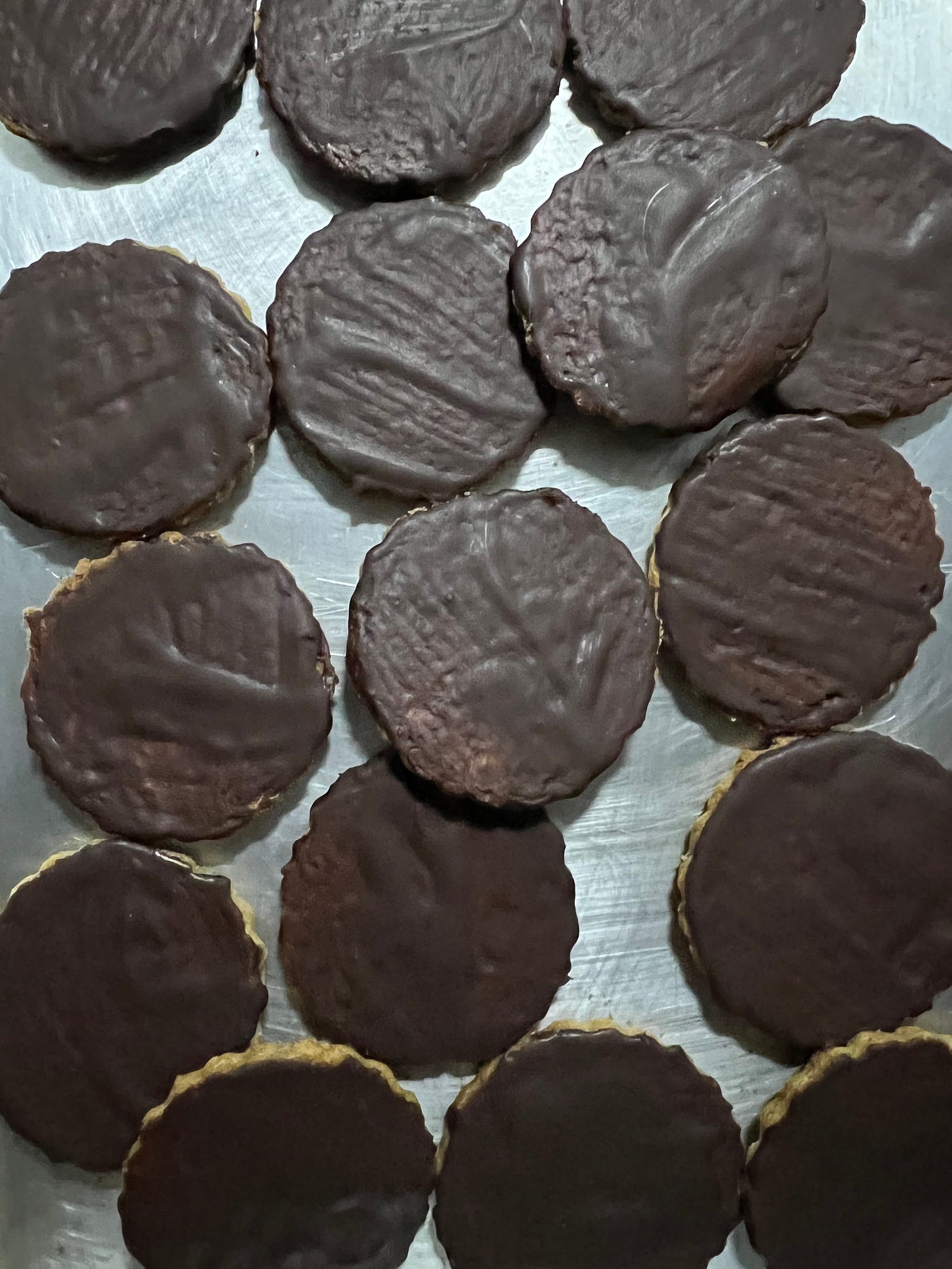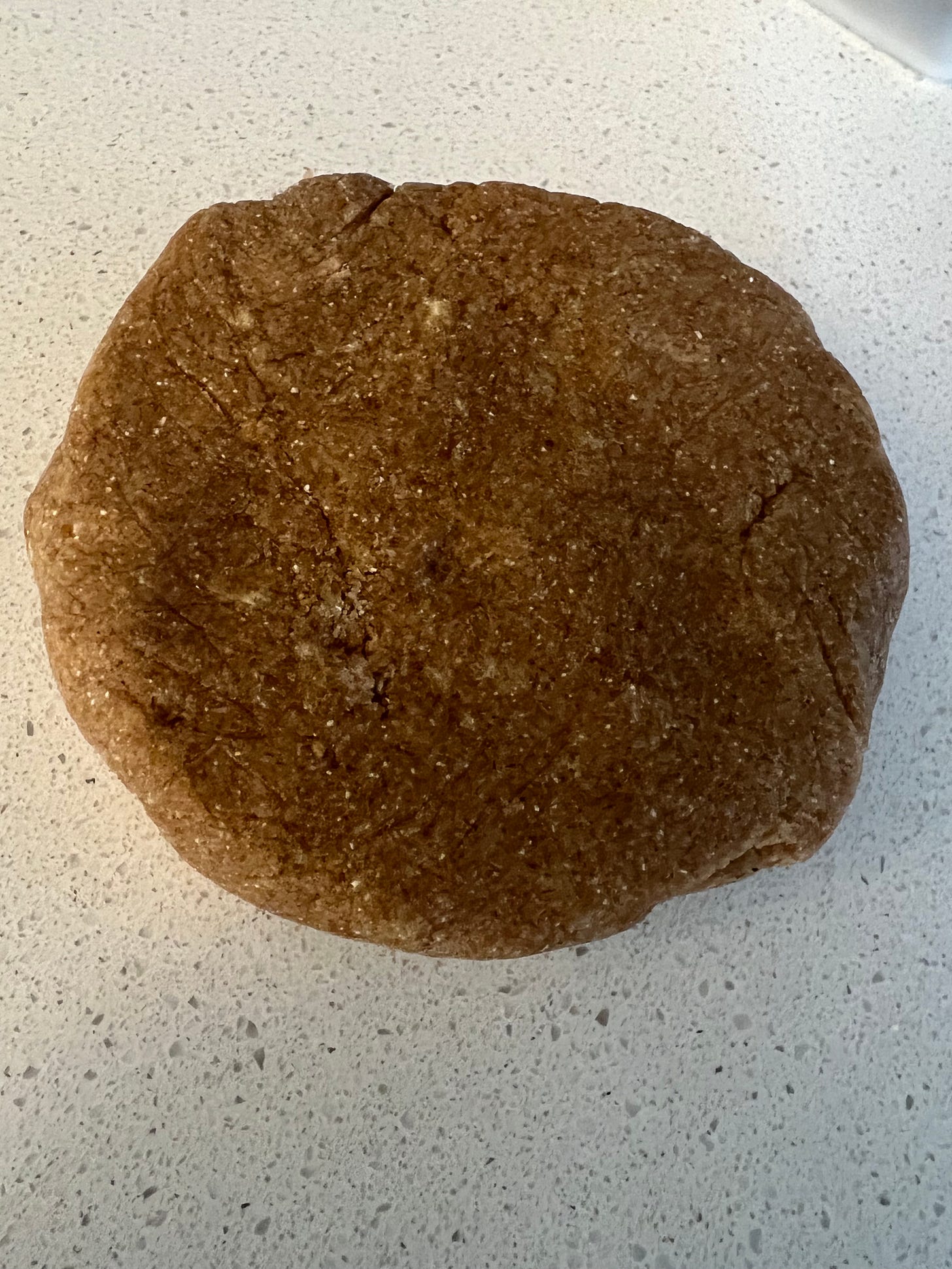Issue #77: Something to Digest
As Seen on TV, Great British Baking, Digestive Biscuits..er...Cookies, Try this at Home, Who Needs McVities?
Somehow the weather went from summer to winter in a day and it did so just in time for Thanksgiving. There are so many sources of Thanksgiving recipes that I’m avoiding the subject entirely. I’ve already given you the recipe for a hash (Issue #75) that makes good use of leftover turkey and is perfect for Sunday brunch, by when you might be hungry again. Maybe the election results will all be in by then, as well, so that you’ll have something to celebrate.
In the meantime, have a listen to the new episode of my podcast What’s Burning, just out today, for which I interview the global pastry phenom Dominique Ansel, creator of the Cronut®. His personal journey from Parisian banlieue to Restaurant Daniel in New York City to World’s Best Pastry Chef (2017) is inspiring and informative.
While I’m plugging projects, if you happen to find yourself heading south for Miami Art Week and/or Art Basel this year, be sure to check out the next installation of Aerobanquets RMX by Mattia Casalegno at Superblue Miami. Presented by Superblue and Meta Open Arts and produced by Flavor Five Studio, a creative shop and tech start-up I co-founded with Mattia and three other partners, this incredible, multisensory, mixed-reality culinary journey is based on the seminal Italian satirical Futurist Cookbook. The food is by James Beard Award-winning, Michelin-starred chef Chintan Pandya (of Semma, Dhamaka, and Adda in NYC), who is one of our partners, and the VR experience is narrated by Gail Simmons (of Top Chef). See for yourself what the New York Times said was “rendered with incredible beauty and precision” and why the Washington Post called it “the future of dining out.” The run goes from November 28 thru December 4. Some tickets remain, but they are going fast amidst the hubbub of the festival. Book today.
Like so many, I have been a fan of the Great British Bake Off (GBBO) since the very first episode of the very first season aired here on Netflix. (Remember that, confusingly, the first season we saw in the U.S. back in 2015 was actually the third season of the show in England.) (Also note that in America it is technically called the Great British Baking Show, I suspect because of a trademark conflict with the Pillsbury Bake-Off®. But I refuse to call it that because it just isn’t as much fun.)
I love the quirkiness of the British amateurs, the concern they have for each other, the dorky humor of the various co-hosts, the real-time, weekly cadence of the competition, the fact that after all of that effort and emotion the starriest of star bakers wins only a plate, not a penny. As with most competition shows, the first season was the best, before those vying for a spot became more self-conscious and performative. As with most shows of the genre, by the time the first contestant arrives who started doing whatever because he or she watched the show growing up, you know the series has jumped the shark. Still, for me, GBBO is an antidote to American reality shows and a salve for the anxiety-filled time we are living in. What’s more, it inspires me to get in the kitchen and—wait for it—“BAKE!”
Over the years I’ve made many things I’ve seen on the show, usually from the technical challenge, for some reason. Maybe I think those recipes will be better because they come from “the professionals,” though that is certainly not always the case. Among the “As Seen On TV” things I’ve made at home are the Apricot Couronne (US Season 2, Week 6), Ciabatta (US S2, W30), a Swedish Prinsesstårta (US S3, W6), and Viennese Whirls (US S5, W2), all of which I’ve enjoyed, but none of which I’ve felt the need to bake again.
And then, just a few weeks ago, I made digestive biscuits from the current season. As I type, I’m eating one from my third batch; crumbs are falling on my keyboard.
I’ve always loved digestives for their somewhat crumbly, fibrous texture, sweet-salty taste, and the feeling that they are cookies that are good for you. From time to time I’ve tried to recreate them at home, but I was never happy with the result. Then a few weeks ago I made Paul Hollywood’s recipe from Week 6, and I deemed it a keeper.
The funny thing is, these digestives were part of a controversial recipe in a controversial season for the show. First, there was the Mexican cold-open fiasco, which many in the American audience found offensive, and which, in a particularly British form of parody, was about how the American audience would probably find it offensive. #irony

Then there were the S’Mores in Week 6, which is where these digestives came in. As many people on social media noted, this ersatz British version of the American bonfire snack that was used for the Technical Challenge would be almost unrecognizable by an American, what with digestives instead of Graham crackers, chocolate glaze instead of melted Hershey bars, and marshmallow pucks tinged with the flame of a torch rather than the requisite flaming sugar balls of fire roasted on sticks.
Still, something about the digestive biscuits looked right to me (if not having any rightful place where a Graham cracker should be). I sought out the recipe online. And, as I already noted above, I’ve made them three times since.
These digestives have a pleasing crumbly, fibrous texture and a salty, buttery taste. Made with a fresh flour, the wheaty flavor is pronounced. I grind my own whole-wheat flour for things like this and for one batch by mistake I had the grinder set more coarse than usual. Although this version didn’t hold its shape very well, it was crumbly and delicious nonetheless. Of course, you can use store-bought whole-wheat flour, too. For the best flavor, I recommend something from a local mill.

For the right look, the cookies are best pressed with a cookie stamp, a set of which I purchased several years ago to make those Viennese Whirls from Season 5. I’ve since had some fun using them on different types of sugar cookies and shortbread. They are not necessary to make digestives. You could just poke a pattern with a fork.
For extra fun—and to encourage my chocolate-lover-but-whole-grain-averse husband to eat these biscuits—I brushed one batch of my digestives with a coating of chocolate glaze, the recipe for which I gave you with the banana cake recipe in Issue #76. (I told you I almost always have some of it in my fridge.) If you glaze them, you’ll need to keep the digestives in fridge so the chocolate stays firm. This also means the cookies stay fresh for weeks. I highly recommend this extra step.
Although I try not to give baking recipes in back-to-back issues of this newsletter, the response to my digestive posts on Instagram was high and several people asked for the recipe. So, here it is. This is based on Paul Hollywood’s original, with a few tweaks and some explanation from my own experience making them over the last couple of weeks. Unlike for the Technical Challenge, you should have all the information you need to succeed.
RECIPE: Digestive Biscuits
1 1/3 cups (170 g) whole-wheat flour, plus additional for dusting
2 tablespoons wheat germ
4 ounces (112 g, 1 stick) unsalted butter, cubed and chilled
1/3 cup plus 1 tablespoon (75 g) light brown sugar
1/2 teaspoon baking powder
1 teaspoon kosher salt
1/4 cup whole milk
All-purpose flour, for dusting
Chocolate glaze, see here (optional)
Combine the flour and wheat germ in the bowl of a food processor fitted with the metal chopping blades and let it run for a few minutes to blend well. Add the chilled butter, sugar, baking powder, and salt, and pulse repeatedly until the mixture resembles fine breadcrumbs.
Add about half the milk, pulse, and dribble additional milk down the feed tube until it forms a stiff dough (you may not need all the milk). Turn the dough out onto the work surface and shape it into a flat disc. Wrap in plastic and chill for at least 20 minutes.
Line a sheet pan with parchment. Lightly flour your work surface with additional whole-wheat flour. Roll out the dough until about 1/4-inch thick. If it cracks, just push it together and keep rolling. As the dough warms it will become more pliable, but if it warms too much it will become sticky. Using a 2-inch round cutter, cut out 16 cookies, re-rolling and cutting the trimmings until no dough remains. Use a small spatula to life the cookies off the counter and arrange them on the prepared pan.
Dip the cookie stamp in all-purpose flour, if using, and tap off any excess. Press each disc to create a pattern, re-flouring the stamp to prevent sticking. Stamping will cause the discs to spread a little, so re-cut them using the cutter to neaten the edges, if necessary.
Preheat the oven to 375°F. Set the sheet pan of cookies in the refrigerator to chill for at least 20 minutes, and preferably more. Bake for 15 to 20 minutes, straight from the fridge, until the edges start to turn a dark golden brown. Leave the cookies to cool on the baking sheets for 10 minutes, then transfer them to a wire rack to cool completely.
If glazing with chocolate, gently melt the glaze over warm water or in the microwave, just until liquid. Using a pastry brush, generously coat the underside of the digestives with chocolate, being careful not to get chocolate on the edge, or to smudge the tops with chocolate on your fingers. Set back on the wire rack for the chocolate to harden. Transfer to the fridge to harden some more before placing in an airtight container to store.











Interesting. I haven't done it but it probably would work. Would likely give them a chewier texture, too.
These look great. I love digestives too. As for the s'mores, maybe the digestive base could work in a Mallomar-esque configuration. They weren't called Mallomars in Canada, but I remember ripping the marshmallow tops off of something similar when I was a kid.